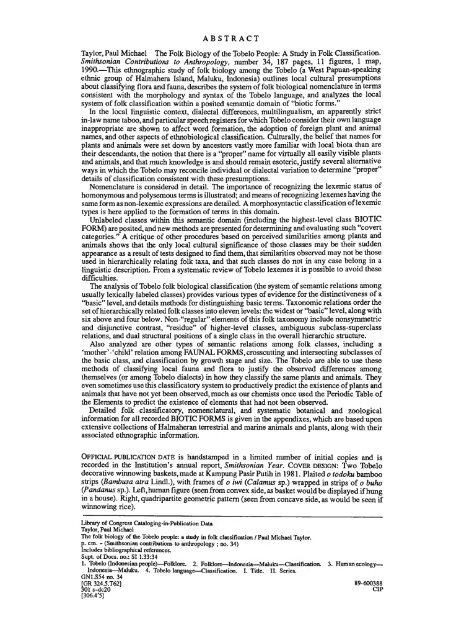The Folk Biology of the Tobelo People - Smithsonian Institution ...
The Folk Biology of the Tobelo People - Smithsonian Institution ...
The Folk Biology of the Tobelo People - Smithsonian Institution ...
Create successful ePaper yourself
Turn your PDF publications into a flip-book with our unique Google optimized e-Paper software.
ABSTRACT<br />
Taylor, Paul Michael <strong>The</strong> <strong>Folk</strong> <strong>Biology</strong> <strong>of</strong> <strong>the</strong> <strong>Tobelo</strong> <strong>People</strong>: A Study in <strong>Folk</strong> Classification.<br />
<strong>Smithsonian</strong> Contributions to Anthropology, number 34, 187 pages, 11 figures, 1 map,<br />
1990.—This ethnographic study <strong>of</strong> folk biology among <strong>the</strong> <strong>Tobelo</strong> (a West Papuan-speaking<br />
ethnic group <strong>of</strong> Halmahera Island, Maluku, Indonesia) outlines local cultural presumptions<br />
about classifying flora and fauna, describes <strong>the</strong> system <strong>of</strong> folk biological nomenclature in terms<br />
consistent with <strong>the</strong> morphology and syntax <strong>of</strong> <strong>the</strong> <strong>Tobelo</strong> language, and analyzes <strong>the</strong> local<br />
system <strong>of</strong> folk classification within a posited semantic domain <strong>of</strong> "biotic forms."<br />
In <strong>the</strong> local linguistic context, dialectal differences, multilingualism, an apparently strict<br />
in-law name taboo, and particular speech registers for which <strong>Tobelo</strong> consider <strong>the</strong>ir own language<br />
inappropriate are shown to affect word formation, <strong>the</strong> adoption <strong>of</strong> foreign plant and animal<br />
names, and o<strong>the</strong>r aspects <strong>of</strong> ethnobiological classification. Culturally, <strong>the</strong> belief that names for<br />
plants and animals were set down by ancestors vastly more familiar with local biota than are<br />
<strong>the</strong>ir descendants, <strong>the</strong> notion that <strong>the</strong>re is a "proper" name for virtually all easily visible plants<br />
and animals, and that much knowledge is and should remain esoteric, justify several alternative<br />
ways in which <strong>the</strong> <strong>Tobelo</strong> may reconcile individual or dialectal variation to determine "proper"<br />
details <strong>of</strong> classification consistent with <strong>the</strong>se presumptions.<br />
Nomenclature is considered in detail. <strong>The</strong> importance <strong>of</strong> recognizing <strong>the</strong> lexemic status <strong>of</strong><br />
homonymous and polysemous terms is illustrated; and means <strong>of</strong> recognizing lexemes having <strong>the</strong><br />
same form as non-lexemic expressions are detailed. A morphosyntactic classification <strong>of</strong> lexemic<br />
types is here applied to <strong>the</strong> formation <strong>of</strong> terms in this domain.<br />
Unlabeled classes within this semantic domain (including <strong>the</strong> highest-level class BIOTIC<br />
FORM) are posited, and new methods are presented for determining and evaluating such "covert<br />
categories." A critique <strong>of</strong> o<strong>the</strong>r procedures based on perceived similarities among plants and<br />
animals shows that <strong>the</strong> only local cultural significance <strong>of</strong> those classes may be <strong>the</strong>ir sudden<br />
appearance as a result <strong>of</strong> tests designed to find <strong>the</strong>m, that similarities observed may not be those<br />
used in hierarchically relating folk taxa, and that such classes do not in any case belong in a<br />
linguistic description. From a systematic review <strong>of</strong> <strong>Tobelo</strong> lexemes it is possible to avoid <strong>the</strong>se<br />
difficulties.<br />
<strong>The</strong> analysis <strong>of</strong> <strong>Tobelo</strong> folk biological classification (<strong>the</strong> system <strong>of</strong> semantic relations among<br />
usually lexically labeled classes) provides various types <strong>of</strong> evidence for <strong>the</strong> distinctiveness <strong>of</strong> a<br />
"basic" level, and details methods for distinguishing basic terms. Taxonomic relations order <strong>the</strong><br />
set <strong>of</strong> hierarchically related folk classes into eleven levels: <strong>the</strong> widest or "basic" level, along with<br />
six above and four below. Non-"regular" elements <strong>of</strong> this folk taxonomy include nonsymmetric<br />
and disjunctive contrast, "residue" <strong>of</strong> higher-level classes, ambiguous subclass-superclass<br />
relations, and dual structural positions <strong>of</strong> a single class in <strong>the</strong> overall hierarchic structure.<br />
Also analyzed are o<strong>the</strong>r types <strong>of</strong> semantic relations among folk classes, including a<br />
'mo<strong>the</strong>r'-'child' relation among FAUN AL FORMS, crosscutting and intersecting subclasses <strong>of</strong><br />
<strong>the</strong> basic class, and classification by growth stage and size. <strong>The</strong> <strong>Tobelo</strong> are able to use <strong>the</strong>se<br />
methods <strong>of</strong> classifying local fauna and flora to justify <strong>the</strong> observed differences among<br />
<strong>the</strong>mselves (or among <strong>Tobelo</strong> dialects) in how <strong>the</strong>y classify <strong>the</strong> same plants and animals. <strong>The</strong>y<br />
even sometimes use this classificatory system to productively predict <strong>the</strong> existence <strong>of</strong> plants and<br />
animals that have not yet been observed, much as our chemists once used <strong>the</strong> Periodic Table <strong>of</strong><br />
<strong>the</strong> Elements to predict <strong>the</strong> existence <strong>of</strong> elements that had not been observed.<br />
Detailed folk classificatory, nomenclatural, and systematic botanical and zoological<br />
information for all recorded BIOTIC FORMS is given in <strong>the</strong> appendixes, which are based upon<br />
extensive collections <strong>of</strong> Halmaheran terrestrial and marine animals and plants, along with <strong>the</strong>ir<br />
associated ethnographic information.<br />
OFFICIAL PUBLICATION DATE is handstamped in a limited number <strong>of</strong> initial copies and is<br />
recorded in <strong>the</strong> <strong>Institution</strong>'s annual report, <strong>Smithsonian</strong> Year. COVER DESIGN: Two <strong>Tobelo</strong><br />
decorative winnowing baskets, made at Kampung PasirPutih in 1981. Plaited o todoku bamboo<br />
strips (Bambusa atra Lindl.), with frames <strong>of</strong> o iwi (Calamus sp.) wrapped in strips <strong>of</strong> o buho<br />
(Pandanus sp.). Left, human figure (seen from convex side, as basket would be displayed if hung<br />
in a house). Right, quadripartite geometric pattern (seen from concave side, as would be seen if<br />
winnowing rice).<br />
Library <strong>of</strong> Congress Cataloging-in-Publication Data<br />
Taylor, Paul Michael<br />
<strong>The</strong> folk biology <strong>of</strong> <strong>the</strong> <strong>Tobelo</strong> people: a study in folk classification / Paul Michael Taylor.<br />
p. cm. - (<strong>Smithsonian</strong> contributions to anthropology ; no. 34)<br />
Includes bibliographical references.<br />
Supt <strong>of</strong> Docs, no.: SI 1.33:34<br />
1. <strong>Tobelo</strong> (Indonesian people)—<strong>Folk</strong>lore. 2. <strong>Folk</strong>lore—Indonesia—Maluku—Classification. 3. Human ecology—<br />
Indonesia—Maluku. 4. <strong>Tobelo</strong> language—Classification. I. Title. II. Series.<br />
GN1.S54 no. 34<br />
[GR 3245.T62) 89-600388<br />
301 s-dc20 CIP<br />
[306.4'5]

















